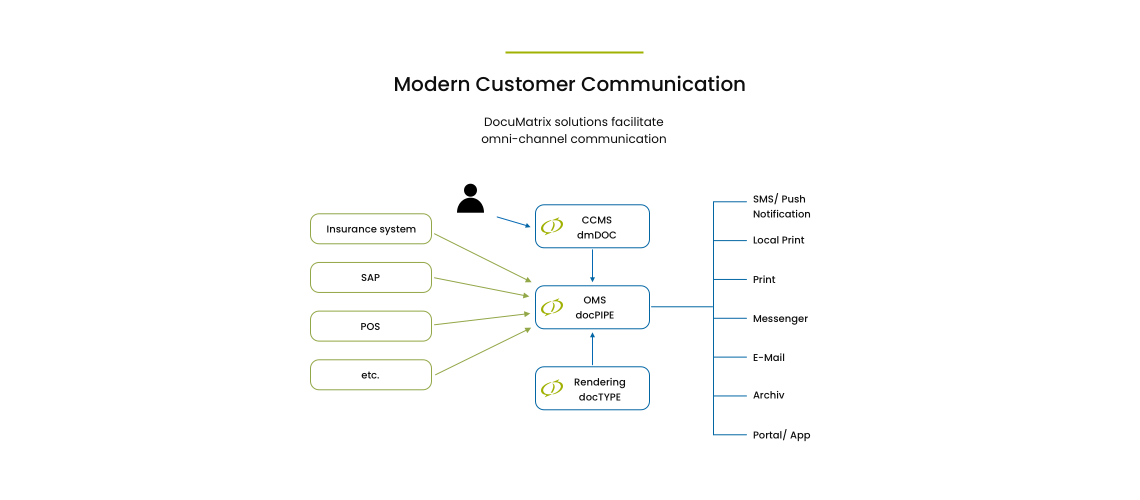From one-channel customer communication to the omnichannel solution
Back when letters still ruled the world, customer communication at major corporations (such as banks and insurance companies) was limited to the postal channel. All printed material was printed centrally and mailed to the customer.
With the increasing number of communication channels, however, the complexity of communication processes has increased significantly, making it necessary to use an
Output-Management-Systems (OMS). This makes it possible to use multiple output formats, either manually or controlled automatically by processes. Fax and print are early examples of these.
This meant that documents could be printed through two routes. The first was decentralised in the specific department, which was costly and did not follow any generally applicable, company-wide regulations. The second was centralised in the printing centre, which was less expensive and complied with the general regulations. However, the actual problem here was that the specific department used an Office system, while the printing centre was operated by the OMS. In this way, two completely different systems were used in order to create customer communication. As a result, quality was not assured and the CI was not necessarily uniform—in addition, archiving and the approval processes were lacking.
However, corporate communications underwent a further transformation due to digitalisation and the higher customer standards that accompanied it. We have now reached a previously unheard-of high point in terms of digitalisation.
Customers want to receive different documents (e.g. insurance policies, energy invoices, portfolio overviews, notifications, etc.) on different channels (e.g. email, postal mail, app, portal etc.) However, no single channel replaces the previous ones; instead, it is more like an additional offering for meeting individual customer needs better and serving groups of customers equally well.
If companies then want to communicate with their customers simultaneously via SMS, instant messenger services, email, their proprietary app, postal mail or fax, the problem of feasibility arises.
In addition, it is no longer necessary to print all documents—but the archive should continue to be well maintained.
“Variety in the customer segment – Variety in customer communication 🌈”
Omnichannel corporate communication
Omnichannel corporate communication makes it possible to put the focus on customers and respond very specifically to their wants and needs. For this purpose, an IT system is required that works together perfectly. With the suitable solution, the departments create the correct documents quickly and easily and send them to the customers over a wide variety of channels. Uniform management ensures quality assurance, archiving and traceability. The departments can collaborate on various documents—no more playing “ping-pong” with documents in the approval process. The dmDOC is an outstanding tool for operation by the departments because it provides an intuitive interface for creating the correct documents quickly.
The docPIPE tool ensures that the right data is available for the right documents and the right customers. In addition, it ensures that these are distributed via the correct channel. Rendering of the data in the background is carried out by the docTYPE tool. Thus state-of-the-art corporate communications on multiple channels can look like this:

The advantages of state-of-the-art omnichannel corporate communications
The advantages of omnichannel customer communication are easy to see.
- Using a central communication platform cuts costs for corporate communications drastically. This pertains both to IT operating costs and the expenses for creating the modules and templates, which have to be defined in just one system.
- Central modules from which documents are generated give companies document templates that are better suited to maintenance. The “single point of change” principle makes it possible to carry out changes once and use them in every communication.
- Clerical employees work with an intuitive system for dynamic document creation—regardless of which channel the document is for. This makes assignment easy!
- System dependencies and complexity are reduced because the communication runs through one central system.
The future of omnichannel communication
DocuMatrix is currently already working on the next phase of quality assurance in document management. In the future, for example, the docPIPE product will be able to be expanded by adding a QAML (“Quality Assurance with Machine Learning”) module. This enables companies to carry out quality assurance on all documents, regardless of output channel. This module will be a further step towards making work easier in document management via automation.

